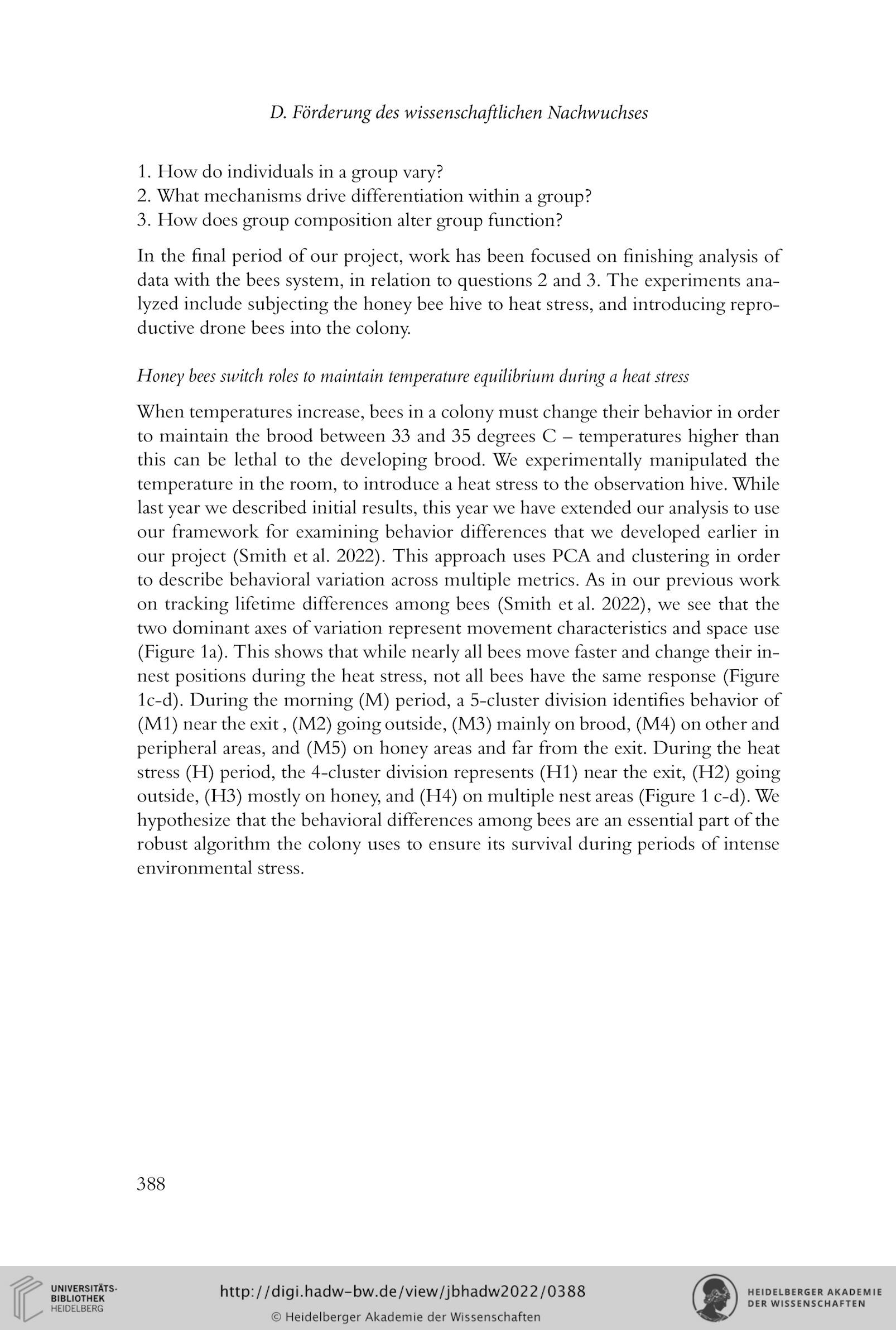D. Förderung des wissenschaftlichen Nachwuchses
1. How do individuals in a group vary?
2. What mechanisms drive differentiation within a group?
3. How does group composition alter group Function?
In the final period of our project, work has been focuscd on Finishing analysis of
data with the bces System, in relation to questions 2 and 3. The experiments ana-
lyzed include subjecting the honey bee hive to heat stress, and introducing repro-
ductive dronc bees into the colony
Honey bees switch roles to maintain temperature equilibrium during a heat stress
When temperatures increase, bees in a colony must change their behavior in order
to maintain the brood between 33 and 35 degrees C - temperatures higher than
this can be lethal to the developing brood. Wc experimentally manipulated the
temperature in the room, to introduce a heat stress to the observation hive. While
last year we described initial results, this year we have extended our analysis to use
our Framework for examining behavior differences that we developed earlier in
our project (Smith et al. 2022). This approach uses PCA and clustering in order
to describe behavioral Variation across multiple metrics. As in our previous work
on tracking lifetime differences among bees (Smith et al. 2022), we see that the
two dominant axes of Variation represent movement characteristics and space use
(Figure la). This shows that while nearly all bees move faster and change their in-
nest positions during the heat stress, not all bees have the same response (Figure
Ic-d). During the morning (M) period, a 5-cluster division identifies behavior of
(Ml) near the exit, (M2) going outside, (M3) mainly on brood, (M4) on other and
peripheral areas, and (M5) on honey areas and far from the exit. During the heat
stress (H) period, the 4-cluster division represents (Hl) near the exit, (H2) going
outside, (H3) mostly on honey, and (H4) on multiple nest areas (Figure 1 c-d). We
hypothesize that the behavioral differences among bees are an essential part of the
robust algorithm the colony uses to ensure its survival during periods of intense
environmental stress.
388
1. How do individuals in a group vary?
2. What mechanisms drive differentiation within a group?
3. How does group composition alter group Function?
In the final period of our project, work has been focuscd on Finishing analysis of
data with the bces System, in relation to questions 2 and 3. The experiments ana-
lyzed include subjecting the honey bee hive to heat stress, and introducing repro-
ductive dronc bees into the colony
Honey bees switch roles to maintain temperature equilibrium during a heat stress
When temperatures increase, bees in a colony must change their behavior in order
to maintain the brood between 33 and 35 degrees C - temperatures higher than
this can be lethal to the developing brood. Wc experimentally manipulated the
temperature in the room, to introduce a heat stress to the observation hive. While
last year we described initial results, this year we have extended our analysis to use
our Framework for examining behavior differences that we developed earlier in
our project (Smith et al. 2022). This approach uses PCA and clustering in order
to describe behavioral Variation across multiple metrics. As in our previous work
on tracking lifetime differences among bees (Smith et al. 2022), we see that the
two dominant axes of Variation represent movement characteristics and space use
(Figure la). This shows that while nearly all bees move faster and change their in-
nest positions during the heat stress, not all bees have the same response (Figure
Ic-d). During the morning (M) period, a 5-cluster division identifies behavior of
(Ml) near the exit, (M2) going outside, (M3) mainly on brood, (M4) on other and
peripheral areas, and (M5) on honey areas and far from the exit. During the heat
stress (H) period, the 4-cluster division represents (Hl) near the exit, (H2) going
outside, (H3) mostly on honey, and (H4) on multiple nest areas (Figure 1 c-d). We
hypothesize that the behavioral differences among bees are an essential part of the
robust algorithm the colony uses to ensure its survival during periods of intense
environmental stress.
388




